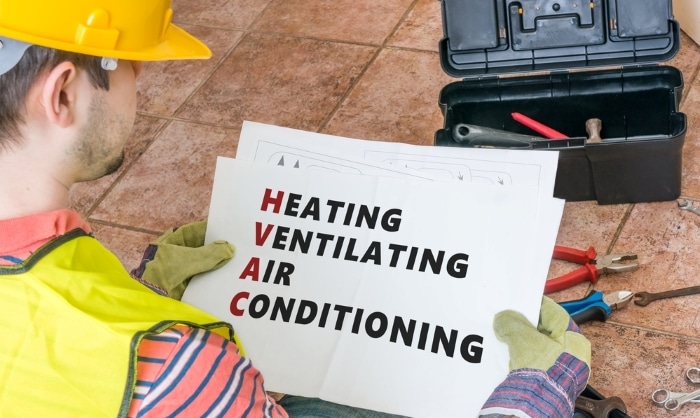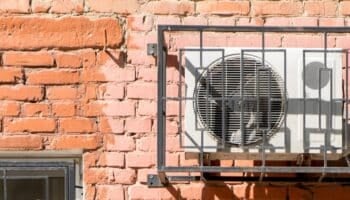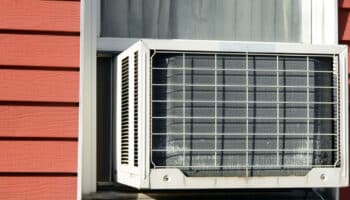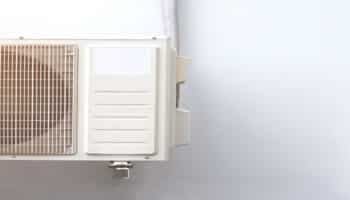Does your window AC have condensation issues, and you’re desperate to find a solution?
You’re not alone! Although Window Air Conditioners provide great relief during hot Summer days, they’re sadly not without flaws.
I know how annoying it can be to have your Window Air Conditioner full of condensation, as it can decrease performance and energy efficiency and eventually damage the appliance.
But don’t worry; you’ve come to the right place for answers. Below, you’ll find a list including 7 top tips that will help you discover what’s causing the condensation and what you can do about it.
When your Window AC is having condensation issues, it can be due to high humidity in your room, using the incorrect appliance size, dirty filters, or a blocked drain pipe. The AC unit could also be improperly installed or insulated.
Read on to keep your Window AC dry!
Why Your Window AC Is Full of Condensation
Many reasons can explain why your Window Air Conditioner is having difficulty dealing with condensation – from something simple, like high humidity levels in your living spaces, to a more complex and concerning issue, like a refrigerant leak.
Here are some tips to help you get the situation under control.
#1 Check Your Room’s Humidity
If your Window AC has condensation issues, I first recommend ensuring your home’s humidity levels are within the normal range. Most health authorities recommend a humidity percentage of 30-50% within living spaces, as that’s the ideal range to prevent dry skin and respiratory tract irritation while also keeping mold growth at bay.
So, if the humidity levels in your home are above 50%, it’s not surprising that your Window AC is having condensation issues.
Solution: Depending on how thorough you want to be, you can buy a hygrometer to measure humidity levels in the room where your Window AC is or get a dehumidifier.
I’d recommend getting the hygrometer first to determine how bad the humidity situation is in your home and then see whether getting a dehumidifier is worth it, as the condensation issue might come from a different factor.
#2 Check Your AC Size
If you accidentally bought the wrong Window Air Conditioner size, it could also be causing condensation issues.
As with many other appliances, nailing the right BTUs or British Thermal Units (the amount of heat required to raise the temperature of 1 pound of water by 1 degree Fahrenheit) plays a key role in ensuring you get the results you’re looking to get from your AC system.

If you buy an undersized Window AC for your room, the appliance will have to work harder to achieve the desired temperature, resulting in overworked internal components and high electricity bills.
On the other hand, if your Window AC is oversized for your needs, it won’t remove humidity as efficiently due to it running shorter cycles. Although both situations can be problematic, condensation is much more likely when the Window AC is oversized.
Solution: If replacing the Window AC is an option, my usual advice is to do that and buy one that’s right for your living space.
In case you can’t replace the appliance, you can also try using Eco-Mode, which, in my experience, typically makes Air Conditioner operation much less intense. By activating Eco-Mode, it will take your oversized Window AC longer to cool the room, resulting in longer cycles and improved dehumidification.
#3 Clean the Filters
Failing to clean your Window AC’s filters often can also result in condensation issues.
As it cools your room, your Window Air Conditioner also removes excess moisture from the surrounding air through several processes. When the filters are dirty, proper airflow is compromised, resulting in less energy-efficient cooling, overheating, and, of course, condensation.
Solution: I’ve found that, under normal conditions, cleaning your AC’s filters (or replacing them if they’re not reusable) every 2-3 months can ensure the appliance delivers great results. However, you’ll have to ramp up the filter cleaning-replacing frequency if:
- You suffer from allergies or have pets.
- You’re using the Air Conditioner daily for several hours, which is common during hot Summer days.
Here’s how to clean your filters:
- Remove the front grill from your Air Conditioner.
- Refer to your User Manual for information on your filters and determine whether they’re reusable.
- If not reusable, replace the filter as per the manufacturer’s guidelines.
- For reusable filters, you’ll have to remove them and use a vacuum cleaner, brush, or cloth to get rid of as much dirt and gunk as possible.
- Combine warm water, dish soap, or any other mild detergent in a spray bottle and thoroughly clean your filter.
- Let the filter dry out completely before putting it back in the Window AC. I’ve found that leaving the filter to dry in the sun is a good way for it to dry. However, if the day is cloudy, you can also use a hair dryer.
You must ensure the filter is completely dry before placing it back into your Window Air Conditioner, as even the slightest degree of moisture can result in further condensation or, even worse – mold.
#4 Check the Drain Pipe
If none of the solutions above have worked and you feel like taking up a challenge, we can start looking at more advanced repairs, such as checking the drain pipe.
In my experience, when Window ACs are working normally, excess condensation is collected and disposed of through the drain pipe, so if the drain pipe is blocked, it could explain why your Window AC is having condensation issues.
Solution: The best way to address the situation is by checking the drain pipe and ensuring no blockages are preventing the part from doing its job.
To check your drain pipe, you’ll need:
- A screwdriver.
- A cloth or towel.
- A bucket or bowl.
- A bottle brush or pipe cleaner.
- White vinegar or mild detergent.
Here’s what you need to do:
- Kill power to your Window AC either by unplugging it or by flipping the switch on your circuit breaker that supplies power to the specific area of the house where the AC is installed.
- Some models must be removed from the window to check the drain pipe, as it typically sits behind a panel.
- Locate the drain pipe (it typically is at the bottom rear end of the unit.
- Check the drain pipe for any kind of blockages.
- Place a little water on the AC’s drain pan (where excess moisture is collected). The water should flow freely from the pan, through the drain pipe, and out the AC.
- If you identify a clog, you can use a pipe cleaner to carefully remove any obstructions, such as dirt buildup.
- Once you’ve scrubbed the pipe properly, apply some white vinegar to the pipe and let it flow through it. White vinegar can unclog your drain pipe and kill mold, mildew, and some bacteria.
- Retest that the drain pipe is not unobstructed by repeating step 5.
- Reassemble your Window AC, reattach it to your window, and restore power to the unit.
I’ve found that if a clogged drain pipe was to blame for your Window AC having condensation issues, the process above should have done the trick.
#5 Check the Tilting
This might surprise you, but Window ACs have to be installed with a slight degree of tilting for them to work normally and remove any excess water they collect.
Although Air Conditioners have motors and all kinds of complex mechanisms inside, they also rely on gravity to do some of the work for them.
Solution: If you suspect your Window AC doesn’t have the necessary tilting level to dispose of the collected humidity properly, you can try reinstalling it with the right angling.
If you’re unsure how to reinstall your Window AC with the proper tilting, please get in touch with a professional who can help you.
#6 Insulate Around the AC
Poor insulation can also explain why your Window AC is having condensation issues.
Proper insulation is key to keeping a home warm, free of excess humidity, and overall in good condition regardless of the seasons or the inclement weather outside. When your Window AC is not properly insulated, excess humidity can get inside the appliance and cause condensation, mold, and many more problems.

Solution: If you suspect your Window AC needs insulation, here’s how you can apply some to yours.
- With the Window AC turned off, use a stick of incense or burned paper with no flame and see whether there’s smoke being pulled towards the window. If so, there’s an air current, which indicates an air leak.
- Apply foam weatherstripping around the edges where your Window AC touches the window frame.
- If you don’t mind how it looks, you can also apply duct tape on top of the weatherstripping foam you just installed to ensure proper sealing.
- Repeat the incense test to see if your efforts worked and the air leaks are gone.
In my experience, insulating your Window AC will help make the appliance’s job easier, use less power, and allow you to get better temperature control results in the process.
#7 Call a Professional
In many cases, even after trying the simple solutions, you’ll still encounter certain condensation problems with your Window AC. And while I’m all for helping people fix their appliances, sometimes a technician’s insight and expertise are needed.

Here are some additional problems that you’ll need to call a pro for:
- A Faulty Temperature Sensor: When your Window AC’s sensor is not working correctly, the appliance will not work as it should. For example, a faulty temperature sensor can result in shorter-than-normal AC cycles, which, as discussed above, can quickly lead to condensation problems.
- Refrigerant Issues: The refrigerant inside your Window AC plays a key role in the appliance’s cooling capacity and functioning. Low refrigerant levels or a leak in the area where the liquid is contained can be very problematic. Please get in touch with a technician to check the refrigerant levels and address any potential leaks.
- Mechanical Failures: Window ACs are full of complex internal components that work together to deliver the results you expect. Any mechanical failure, such as a faulty fan, can affect airflow and cause excess condensation.
Addressing Condensation in Your Window AC
That about covers it!
When your Window AC is having condensation issues, it’s understandable that you’re worried about the potential cost of repairs of having it fixed.
Luckily, as I hope this piece has helped you better understand, addressing the most common causes behind a Window AC with excess condensation is easy. More often than not, a simple fix, such as cleaning the filters, can go a long way.
Thanks for reading. If this article was useful and answered your questions, please check out our other resources and free guides below and consider subscribing to our newsletter.
Have a great day!
-Craig.








